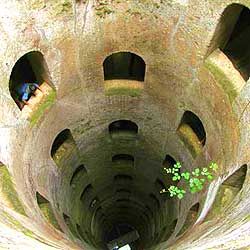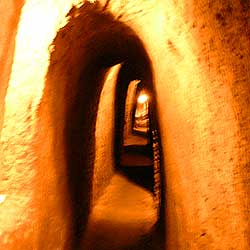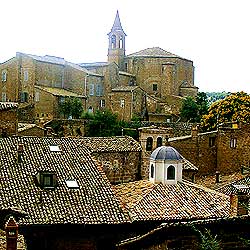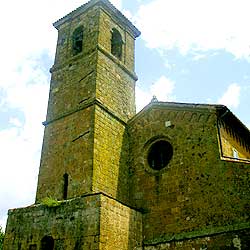

![]()
The last stop of cable car (Funicolare) is Cahen plaza (Piazza Cahen). The world famous holy well of St. Patrizio is situated near this plaza.
This well was built by order of Pope Clement VII (Giulio de Medici). In 1527, at the time of Roman sack, he had refuged in Orvieto and asked to make this well to ensure water for the siege.
The design was made by the Florentine architect Antonio da Sangallo Il Giovane. The well was completed in 1537, ten years after the construction starting, in the period of Pope Paul III (Alessandro Farnese di Roma). It's a well hollowed in the giant rock of tuff, 62 m depth and 13-14 meters wide. Around the water pipes there are two spiral staircases of 248 steps. One for going down to draw water and one for carrying water to the ground. These spirals are designed not to collide.
Going down into a well of 62 meters, and seeing a rare view from the bottom are really fantastic experience. In Italy, spenders without limit are called "to have a bottomless pockets like the well of St. Patrizio".

![]()
Beneath the beautiful town of Orvieto, there is a labyrinth of the huge underground caves. Tuff forming the land of Orvieto has been used for the palaces, churches and houses as building material. Since it's soft and easy to work but durable and strong, even in the antique period it was considered very important.
Therefore BC Etruscan era, underground passages and tunnels had been caved. And the underground town had been created in a huge and mysterious form. Several caves have small wells, stock flour rooms, repair tool rooms, domestic animal barns etc. There are thousands of caves in total and it's said that it would be bigger than the town of Orvieto on the ground.
It's now able to explore underground caves in several parts, such as the Duomo side.

![]()
The city of Orvieto still keeps a faithful image of its past. Especially from the center of the town, the square Repubblica (Piazza della Repubblica) to the northwest area, there are many buildings of 12-13th century. Characteristic panorama is winding narrow streets and arches, low and irregular figured houses made of tuff and basalt. Those views make a very interesting unique sight of this town.
In this area there is the oldest church in Orvieto, San Giovenale. A great panorama from the square in front of the church is overlooking the other hills outside walls. That is the best viewpoint of Orvieto.
Go to the direction of counter-clockwise along the cliff walls from this square, you will come into the Maitani street in front of the Duomo. When you visit Orvieto, let's walk by your feet all means, and fully enjoy historic streets and beautiful countryside of Umbria called "Green Heart".
There is also a beautiful palace of Petrangeli in this area. The courtyard of the early Renaissance colonnade is worth to visit. (Street address Malabranca 22)

![]()
Church of Saint Giovenale in the northwest corner of the town was built in 1004, the oldest church in Orvieto. The front entrance of the church is very simple and has a round arched door and a mighty bell tower rises at the left side. Still now this bell tower tells the time to the people in Orvieto. To the right, there is a gate of tuff made in 1497. The Runetta (half-moon part) has a bust of bishop St. Giovenale.
Inside the church precious frescoes are barely left along the walls. It's said that these are works of artists of Orvieto from the 13-16th century. Including these frescoes, the churches in Orvieto keep a lot of important works in art history. It's worth to see and try to explore other beautiful churches.